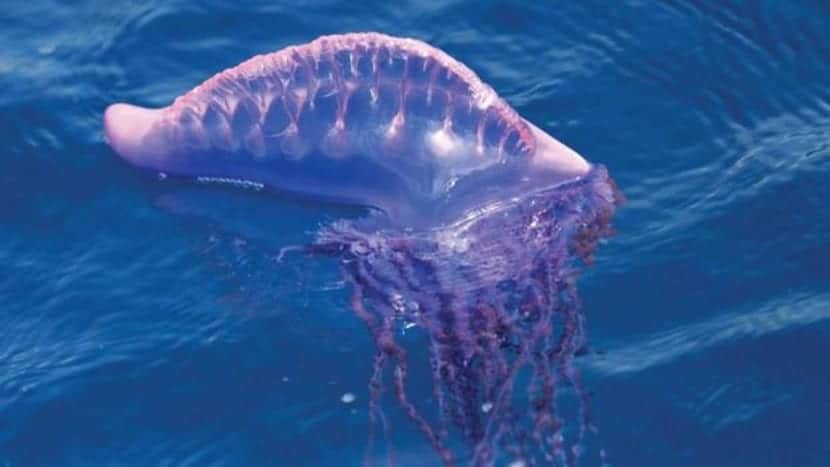
The world of jellyfish is full of curiosities and truly spectacular species. After carefully viewing and analyzing the immortal jellyfish, today we enter fully with another very famous and impressive specimen. It's about the caravel jellyfish. It is also known by the name of bad water, although it is considered a false jellyfish. It really is a hydrozoa (water snake) and the bite is quite dangerous.
In this article we are going to unravel all the secrets of the caravel jellyfish telling what are its characteristics, way of life and what you should do in case this species bites you.
Key features
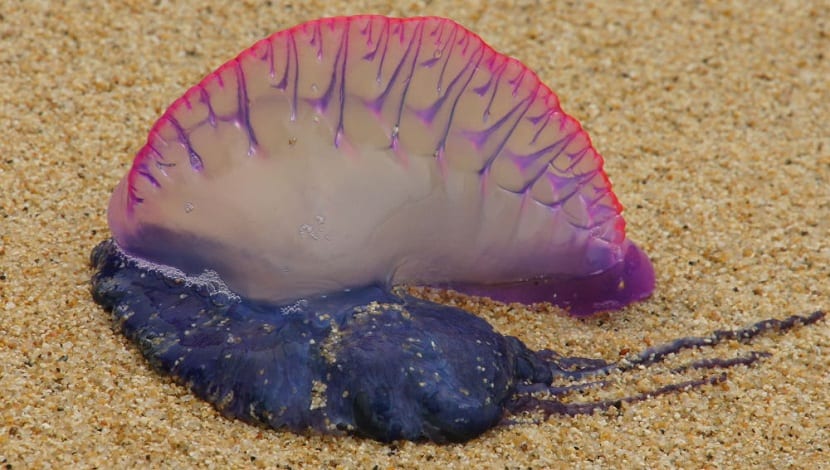
His scientific name is Physalia physalis. It is a species of siphonophore hydrozoan that belongs to the Physaliidae family. One of the characteristics that represents this type of animal is that his body is colonial and not individual. That is, it has a body that is formed by the union of numerous living beings that cooperate with each other and not by a single individual. It is a jellyfish that moves quite well through warm waters, so we can see it often near certain coasts. This increases the danger of bites to bathers.
The tentacles are usually 1 meter long, although specimens that can be up to 3 meters long have been found. What makes it dangerous is that it has a stinging substance that can paralyze a large fish. This means that the human being who is stung will suffer serious consequences. Belonging to the order of cnidarians, it has cnidocytes. These are its toxins capable of poisoning anyone who gets in front of it. It is a protein poison that has the potential to paralyze its prey.
To attack prey, it wraps itself around them and traps them with its long venom-filled tentacles. One part of its body is floating on the sea surface, while the other part is submerged watching for possible prey. When they walk in large groups they feel more protected than in smaller communities. They are forming communities capable of reaching almost a thousand specimens, so a horde of these jellyfish are really dangerous.
There are only a few species that are immune to its venom, such as the clownfish and the caravel fish. They do not take damage when they are grasped between their tentacles.
Habitat and distribution
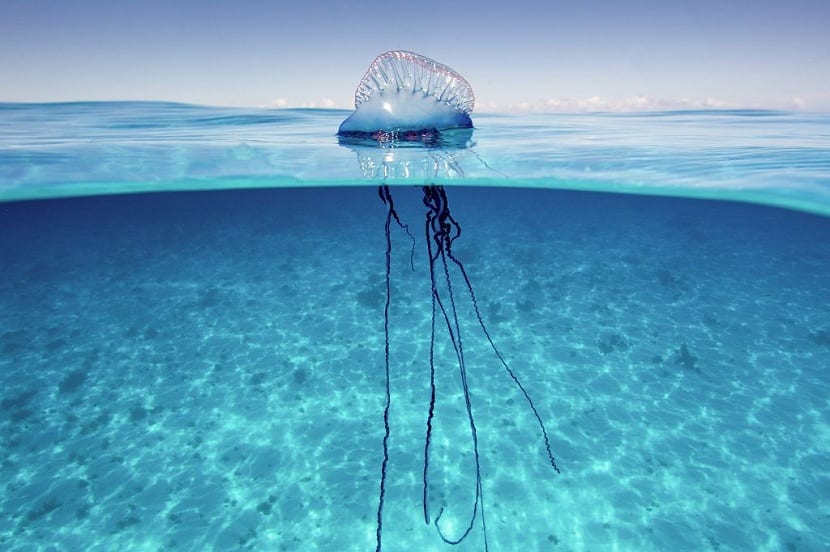
The caravel jellyfish is not good at swimming in cold waters, but in areas with a tropical climate where the water temperatures are warmer. On the other hand, it can do well in more temperate climates, but it is less likely that there will be a greater number of copies continuously.
The area where most of the individuals are concentrated is in the Pacific Ocean. Quite large populations have also been sighted in some specific areas of the Atlantic and others, but much smaller, in the Indian Ocean. They have also arrived in Spain and we have found numerous cases in which it has been seen in the Mediterranean Sea. We know this can be a problem for a bather. Therefore, later, we will see what we should do before the bite.
Feeding the caravel jellyfish
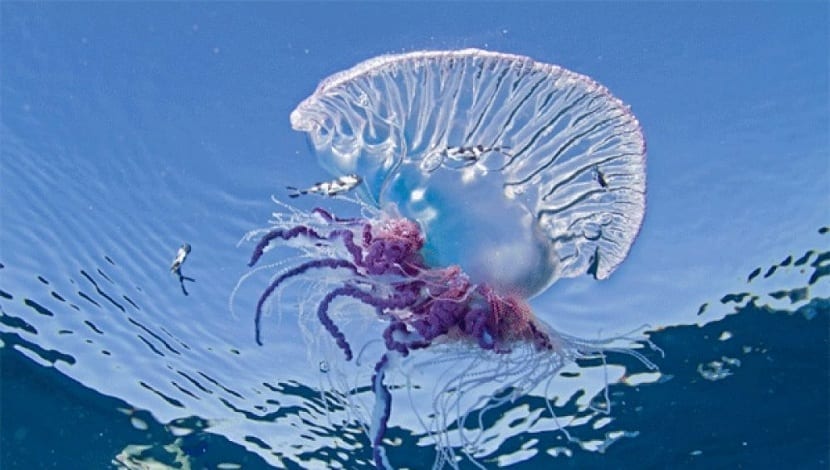
In order to feed, this jellyfish paralyzes its prey with the poison that it gives off from its tentacles and eats them through its gastric cavity. They also eat zooplankton and krill larvae. Jellyfish that are already adult can ingesting shrimp, prawns, crabs, fish, and eggs of other species. If food is scarce, they are able to eat other jellyfish.
These jellyfish do not have a respiratory organ or apparatus. His breathing is shallow. They do this by passive diffusion of gases between the water and your body through the skin. It is thanks to this gas exchange that it can breathe.
Reproduction
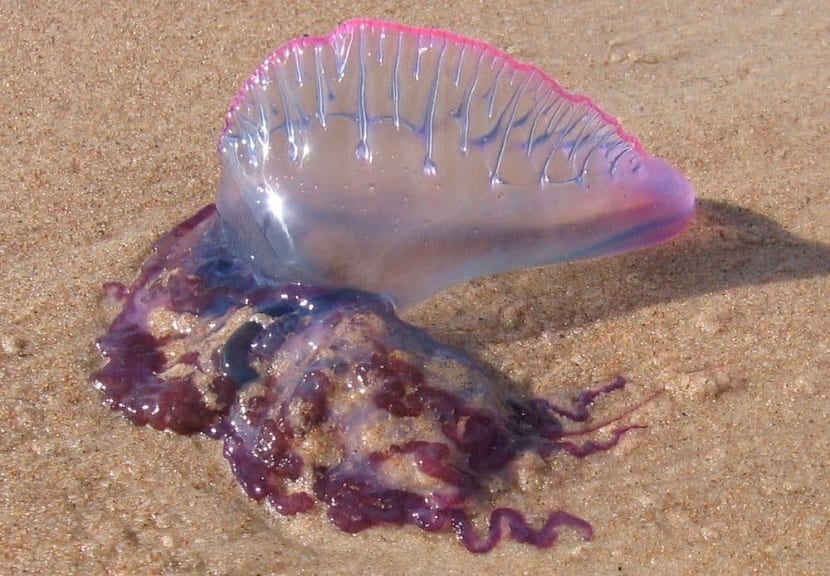
The caravel jellyfish has both sexes separated, that is, they are dioecious. During their reproductive stage, they usually release sperm and eggs into the water.. This is where fertilization occurs. It can also happen that the sperm fertilize the eggs in the internal part of the body of the female jellyfish.
Normally, depending on the environmental conditions and its characteristics, the life expectancy of this jellyfish is quite low. They usually reach 6 months of life only. Although they are far from the coast, there are some marine currents that can drag them to them and harm bathers.
These jellyfish are not the kings of the sea, but they also have their predators. Among them we find the loggerhead turtle, hawksbill, sea slug, sunfish and the octopus blanket. Some salmon and swordfish also sometimes eat them.
What does he do with the sting of the caravel jellyfish
The bite of this hydrozoan is very painful and until now an effective treatment has not been found. At present it is being put to Try treating the bite with -78 degree dry ice. In these cases, the best is prevention. There is an app called infomedusas that shows you the maps with the highest frequency of jellyfish and their concentration. In this way, it is better not to bathe or to be better monitoring the waters through which we bathe. If you spot one, the best thing to do is get out of the water and go no further.
Although many people do, It is not indicated to use vinegar, ammonia or urine for the treatment of jellyfish. If the pain does not subside after its application with seawater and after removing the tentacles, it is best to go to the doctor as soon as possible. There should always be guard posts on the beach and primary treatments. Therefore, it is better to go to have a good review.
As you can see, there are animals that are very dangerous for humans. Although they are not naturally on the coasts, many ocean currents carry them. In addition, with global warming, the waters that were cold before are now more tolerable for them.